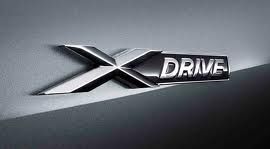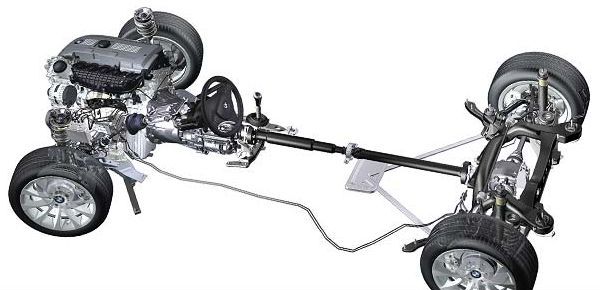BMW xDrive – Autoubik
 The xDrive two-axle drive system was first introduced by BMW in the X3 in 2003 and soon after with the redesigned X5. Gradually, this advanced system has penetrated into other models of the brand.
The xDrive two-axle drive system was first introduced by BMW in the X3 in 2003 and soon after with the redesigned X5. Gradually, this advanced system has penetrated into other models of the brand.
However, BMW switched to all-wheel drive much earlier. The history of the first car with blue and white propeller and the drive of both axles dates back to the interwar period. In 1937, it was ordered by the then Wehrmacht, and it was an open four-door car with a canvas roof. Subsequently, the automaker's 4×4 drive remained on the sidelines for a long time, until the rival Audi Quattro model appeared, which could not leave the automaker BMW idle. In 1985, the all-wheel drive model E30, the BMW 325iX, was launched into series production. In 1993, he also fitted the BMW 525iX upper mid-range sedan with more modern technology to work with the all-wheel-drive ABS system. The center differential with electromagnetic control made it possible to distribute torque in the range of 0-100%, and the rear differential distributed the force to the wheels through an electro-hydraulic lock. A further evolution of the all-wheel drive system, equipped with three differentials, consisted in replacing their locks with braking of individual wheels, which was responsible for the DSC stabilization system. During normal driving, the torque was divided into individual axles in a ratio of 38:62%. Such a system was used, for example, in the E46 models or the pre-facelifted X5 models. In further developing the 4×4 drive system, BMW relied on the fact that most owners of such vehicles rarely hit the road, and when they do, it's usually just easier terrain.

What is xDrive?
xDrive is a permanent all-wheel drive system that interacts with the DSC electronic stabilization system, containing a multi-plate clutch that replaces the classic mechanical center differential. In developing the new all-wheel drive system, BMW's aim was to maintain, in addition to improving the vehicle's traction, the typical driving characteristics of the classic front and rear engine concept.
Engine torque is distributed by an electronically controlled multi-plate clutch located in the distribution gearbox, which is generally located downstream of the gearbox. Depending on the current driving conditions, it distributes the torque between the front and rear axles. The xDrive system is connected to the DSC stabilization system. The speed at which the clutch is fully engaged or disengaged is less than 100ms. The cooling of the oil fill, in which the multi-plate clutch is located, is called the so-called push. This means that the outer casing has fins that dissipate excess heat into the surrounding air due to the rush of air during movement.
Like the competitive Haldex system, xDrive is constantly being improved. The current priority is to increase the efficiency of the entire system, which leads to a reduction in the overall fuel consumption of the vehicle. The latest version has an integrated multi-plate clutch control servomotor in the gearbox housing. This eliminates the need for an oil pump, resulting in fewer parts throughout the system. The latest evolution of the xDrive system provides a 30% reduction in friction losses, which means an overall reduction in fuel consumption of 3 to 5% (depending on vehicle type) compared to the first generation. The task is to get as close as possible to the fuel consumption of a model with only a classic rear-wheel drive. Under normal driving conditions, the system distributes torque to the rear axle in a ratio of 60:40. Since many fans of the brand initially criticized the xDrive model for being less nimble, bulky, and also prone to understeer in tighter turns, the manufacturer worked on tuning. Thus, in the latest developments, the rear axle is preferred to the maximum extent, of course, while maintaining the necessary overall traction and vehicle safety while driving. The xDrive system is available in two versions. For limousines and station wagons, the so-called more compact solution, meaning that the transmission of engine power to the drive shaft leading to the front axle is provided by a gear wheel. Off-road vehicles such as the X1, X3, X5, and also the X6 use an sprocket to transmit torque.

Description of the system and xDrive in practice
As already mentioned, xDrive reacts very quickly to changing driving conditions. In comparison, the 100 ms required to fully engage or disengage the clutch is significantly less time before the vehicle can respond by accelerating to an immediate change in accelerator pedal position. This is due to the fact that between pressing the accelerator pedal and the reaction of the engine in the form of an increase in power, about 200 milliseconds elapse. Of course, we are talking about a naturally aspirated gasoline engine, in the case of supercharged engines or diesel engines, this time is even longer. Thus, in practice, the xDrive system is ready before the compressed accelerator reacts. However, the operation of the system does not end only with a change in the position of the accelerator. The system is dynamic or rather predictable for other driving parameters and constantly monitors the state of the car in order to distribute the engine torque between the two axles as optimally as possible. Under the microscope, for example, the lateral acceleration sensor is responsible for the speed of rotation of the wheels, the angle of their rotation, centrifugal force, the turn of the vehicle or the current engine torque.
Based on information received from various sensors, the system can determine whether a response is required if the vehicle tends to oversteer or understeer. When the understeer leans – the front wheels point to the outer edge of the curve – an electronically controlled multi-plate clutch redistributes torque from the front axle to the rear in tens of milliseconds. By tending to oversteer, i.e. when the rear end is facing the edge of the road, xDrive redirects the engine's driving force from the rear axle to the front, and the so-called. pulls the car out of the inevitable skid. Thus, an active change in the distribution of engine torque prevents the intervention of the DSC stabilization system, which is activated only when the traffic situation requires it. By linking the xDrive system to DSC, engine intervention and brake control can be activated in a much gentler manner. In other words, the DSC system does not intervene if the appropriate distribution of engine power is itself capable of eliminating the risk of oversteer or understeer.
When starting off, the multi-plate clutch is locked at a speed of approximately 20 km / h, so that when accelerating, the vehicle has maximum traction. When this limit is exceeded, the system distributes engine power between the front and rear axles depending on the current driving conditions.
At low speeds, when high engine power is not required and the vehicle is turning (for example, when cornering or parking), the system disengages the front axle drive and the engine power is transferred only to the rear axle. The aim is to reduce fuel consumption as well as limit the influence of unwanted forces on driving.
Similar system behavior can be seen at high speeds, for example. when driving smoothly on the highway. At these speeds, continuous drive to both axles is not required, as this will increase component wear as well as increase fuel consumption. At speeds above 130 km / h, the control electronics issues a command to open the center multi-plate clutch, and the engine power is transmitted only to the rear wheels.
On low traction surfaces (ice, snow, mud), the system pre-locks traction for best traction. But what if one wheel has good traction and the other three are on slippery surfaces? Only the model equipped with the DPC system can transfer 100% of the engine power to one wheel. Using a differential and a DPC (Dynamic Performance Control) system located on the rear axle, torque is actively redistributed between the right and left rear wheels. This is how the BMW X6 is equipped, for example. In other vehicles, 100% of the engine power is transferred to the axle where the wheel with the best grip is located, for example, if there are three wheels on ice and one, for example on asphalt. In this case, the system divides the ratio of 50:50 for both the right and left wheels, while the wheel on a surface with less grip is braked by DSC so that there is not too much oversteer. In this case, the system distributes engine power only between the axles and not among the individual wheels.
The xDrive system also benefits from minimal maintenance requirements. The manufacturer recommends changing the oil after about 100 - 000 km, especially for vehicles that are often used on dirt roads or are used to tow a trailer. The xDrive system adds approximately 150 to 000 kg to the vehicle's weight, and fuel consumption, depending on engine version and type, is between 75 and 80 liter of fuel compared to rear-wheel drive models only.